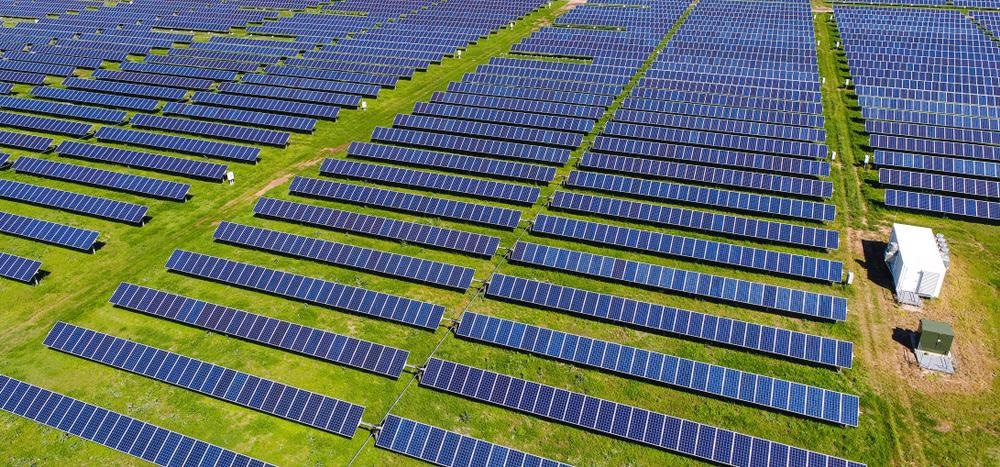Researchers at the Fraunhofer Institute for Solar Energy Systems ISE have achieved a new record for energy transfer efficiency in a photovoltaic cell. The conversion efficiency of 68.9% is the highest recorded to date.

Image Credit: Roschetzky Photography/Shutterstock.com
The scientists behind this recent breakthrough used an III-V class semiconductor photovoltaic cell based on gallium arsenide (GaAs) exposed to laser light with a wavelength of 858 nm.
This impressive result demonstrates that photovoltaic power transfer has applications beyond solar renewable energy. The phenomenon may be used for other wireless power transfer applications in the future, thanks to this record-breaking advance in conversion efficiency.
Growing Photovoltaic Cells on GaAs Substrate
The team used photovoltaic cells grown on a GaAs substrate to demonstrate its record-breaking power conversion efficiency. GaAs is an III-V direct bandgap semiconductor and has a zinc-based crystal structure.
The team studied different thin-film photovoltaic cell materials before selecting GaAs. Cells with back-surface reflectors made of gold and an optically optimized combination of ceramic and silver were examined. The team developed an n-GaAs/p-AIGaAs heterostructure for the battery absorber and used it for its low charge carrier losses from recombination.
GaAs is frequently used as a substrate material for epitaxial growth of other III-V class semiconductors, including for GaAs. This is how the researchers grew photovoltaic cells on a GaAs substrate.
GaAs is a good material for high-efficiency photovoltaic cells and is frequently selected for research purposes. GaAs’s first known operational use as a high-performing solar cell was in NASA’s Venera 3 mission, which launched in 1965. NASA selected GaAs solar cells due to their ability to perform in high-temperature environments.
GaAS can be used in single-crystalline thin-film photovoltaic cells as well as multi-junction cells.
Nanomanufacturing with Thin Films
The researchers removed the GaAs substrate from their photovoltaic cell once it had been epitaxially grown. Then, a thin-film, conductive, highly reflective mirror was applied to the remaining superconductor structure.
This thin-film manufacturing approach enabled the highest possible efficiency in the final photovoltaic cell. In the cell, photons are trapped and absorption for photon energy is highest close to the bandgap. The thin-film mirror contains photons within the cell, enabling them to be recycled so that maximum energy can be converted.
Trapping photons close to the bandgap with the thin film mirror also minimizes energy losses through thermalization and transmission. As well as improving the performance of the photovoltaic effect, this also results in increased voltage for the cell due to a longer effective carrier lifetime.
Applications for Photovoltaic Cells Beyond Solar Energy
The photovoltaic effect has been widely used to generate renewable solar energy with solar cells. However, the team behind this latest energy conversion efficiency breakthrough believes that photovoltaic power transfer has applications beyond solar power.
So-called “power by light” can distribute energy through the air or via optical fibers to a photovoltaic cell. As light can travel with minimal loss of power, energy could be distributed in this way over long distances with optimal efficiency.
Applications that need galvanically isolated power supplies, for example for lightning protection or electromagnetic compatibility, could all benefit from wireless power transfer using optics.
This development in photovoltaic cell efficiency brings those applications a few years closer to their full conceptual realization.
References and Further Reading
Helmers, Henning, et al. (2021). 68.9% Efficient GaAs-Based Photonic Power Conversion Enabled by Photon Recycling and Optical Resonance. Phys. Status Solidi RRL. [Online] https://doi.org/10.1002/pssr.202100113.
Disclaimer: The views expressed here are those of the author expressed in their private capacity and do not necessarily represent the views of AZoM.com Limited T/A AZoNetwork the owner and operator of this website. This disclaimer forms part of the Terms and conditions of use of this website.